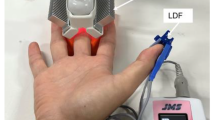Abstract
Purpose
The facial skin blood flow (SkBF) shows regional differences in the responses to a given stimulation. The facial SkBFs, especially in the eyelid and nose exhibit unique response to physiological and psychological stimuli, but the mechanisms inducing those regional differences remain unclear. To investigate whether the regional differences in the local control of vasomotion in facial vessels correspond to the regional differences in facial SkBF response, we monitored the relative change of facial SkBF to regional thermal stimulation. We hypothesized that heat stimulation dilates the cutaneous vessels in the eyelid, while cold stimulation constricts those in the nose, which was based on previous findings
Methods:
A thermal stimulator was used to apply temperature increase (from 20 to 40 °C at 2 °C/min) and decrease (from 40 to 20 °C at 2°C/min) in a randomized order to the right eyelid, nose, right cheek, and forehead of 14 healthy young males. The facial SkBF was measured for 10 s using laser-speckle flowgraphy when temperatures of 20 °C, 30 °C, and 40 °C had been applied for 30 s in both trials.
Results
The SkBF in the eyelid did not change significantly during any thermal stimulation, and the nasal SkBF did not decrease significantly during cold stimulation. The SkBFs in the cheek and forehead increased significantly with the applied temperature.
Conclusions
These findings indicate that a large regional variation exists in facial skin blood flow response to local heating or cooling and that the regional variation did not correspond to the unique SkBF responses in the previous studies.




Similar content being viewed by others
Abbreviations
- ANOVA:
-
Analysis of variance
- MAP:
-
Mean arterial pressure
- NO:
-
Nitric oxide
- SE:
-
Standard error
- SD:
-
Standard deviation
- SkBF:
-
Skin blood flow
- TD:
-
Trial temperature-decrease trial
- TI:
-
Trial temperature-increase trial
References
Drummond PD (1994) Sweating and vascular responses in the face: normal regulation and dysfunction in migraine, cluster headache and harlequin syndrome. Clin Auton Res 4:273–285
Drummond PD (1995) Mechanisms of physiological gustatory sweating and flushing in the face. J Auton Nerv Syst 52:117–124
Drummond PD, Lance JW (1987) Facial flushing and sweating mediated by the sympathetic nervous system. Brain 110:793–803
Hodges GJ, Zhao K, Koshiba WA, Johnson JM (2006) The involvement of nitric oxide in the cutaneous vasoconstrictor response to local cooling in humans. J Physiol 574:849–857
Izumi H, Karita K (1993) Innervation of the cat lip by two groups of parasympathetic vasodilator fibres. J Physiol 465:501–512
Johnson JM, Minson CT, Kellogg DL Jr (2014) Cutaneous vasodilator and vasoconstrictor mechanisms in temperature regulation. Compr Physiol 4:33–89
Kashima H, Hayashi N (2011) Basic taste stimuli elicit unique responses in facial skin blood flow. PLoS One 6:e28236
Kashima H, Hayashi N (2013) Facial skin blood flow responses to irritant stimuli in the oral cavity. Auton Neurosci 174:61–65
Kashima H, Ikemura T, Hayashi N (2013) Regional differences in facial skin blood flow responses to the cold pressor and static handgrip tests. Eur J Appl Physiol 113:1035–1041
Kashima H, Hamada Y, Hayashi N (2014) Palatability of tastes is associated with facial circulatory responses. Chem Senses 39:243–248
Kellogg DL Jr, Zhao JL, Wu Y (2009) Roles of nitric oxide synthase isoforms in cutaneous vasodilation induced by local warming of the skin and whole body heat stress. J Appl Physiol 107:1438–1444
Kuchiiwa S, Izumi H, Karita K, Nakagawa S (1992) Origins of parasympathetic postganglionic vasodilator fibers supplying the lips and gingivae; an WGA-HRP study in the cat. Neurosci Lett 142:237–240
Kuraoka K, Nakamura K (2011) The use of nasal skin temperature measurements in studying emotion in macaque monkeys. Physiol Behav 102:347–355
Minson CT, Berry LT, Joyner MJ (2001) Nitric oxide and neurally mediated regulation of skin blood flow during local heating. J Appl Physiol (1985) 91:1619–1626
Nakayama K, Goto S, Kuraoka K, Nakamura K (2005) Decrease in nasal temperature of rhesus monkeys (Macaca mulatta) in negative emotional state. Physiol Behav 84:783–790
Nozawa A, Tacano M (2009) Correlation analysis on alpha attenuation and nasal skin temperature. J Stat Mech P01007:1–10
Yamazaki F, Sone R, Zhao K, Alvarez GE, Koshiba WA, Johnson JM (2006) Rate dependency and role of nitric oxide in the vascular response to direct cooling in human skin. J Appl Physiol (1985) 100:42–50
Zenju H, Nozawa A, Tanaka H, Ide H (2004) Estimation of unpleasant and pleasant states by nasal thermogram. IEEJ Trans Electron Inf Syst 124:213–214
Acknowledgements
This work was supported by JSPS KAKENHI grants: number 15J11556 to A.M. and number 26560396 to N.H.
Author information
Authors and Affiliations
Contributions
AM, SH and NH designed the study, contributed to analysis and interpretation of data, and assisted in the preparation of the manuscript. AM and SH wrote the initial draft of the manuscript. SH have contributed to data collection. AM and NH have contributed to interpretation, and critically reviewed the manuscript. All authors approved the final version of the manuscript, and agree to be accountable for all aspects of the work in ensuring that questions related to the accuracy or integrity of any part of the work are appropriately investigated and resolved.
Corresponding author
Ethics declarations
Conflict of interest
The authors have no financial conflict of interest.
Additional information
Communicated by Keith Phillip George.
Publisher’s Note
Springer Nature remains neutral with regard to jurisdictional claims in published maps and institutional affiliations.
Rights and permissions
About this article
Cite this article
Miyaji, A., Hayashi, S. & Hayashi, N. Regional differences in facial skin blood flow responses to thermal stimulation. Eur J Appl Physiol 119, 1195–1201 (2019). https://doi.org/10.1007/s00421-019-04109-6
Received:
Accepted:
Published:
Issue Date:
DOI: https://doi.org/10.1007/s00421-019-04109-6




